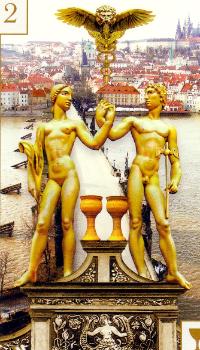The Mystery of the Coniunctio
The drama of opposites and their reconciliation

Two of Cups, Tarot of Prague
We meet ourselves time and again in a thousand disguises on the path of life.
C. G. Jung
As we continue our trajectory through the various stages in alchemy, we eventually arrive at a new form of coagulatio made possible through the mystery of the coniunctio, which Carl Jung defined as the marriage of the opposites and considered the most important process in alchemy.
The alchemists searched for the elixir of life or the lapis or Philosopher’s Stone through their work or opus, which at the psychospiritual level meant finding and extracting the soul in matter as a way to reach the essence of being. The alchemical coniunctio was, first of all, any chemical combination that rendered a new coagulatio while working simultaneously on the three levels, the physical, the mental and the spiritual, just like all of the operations in alchemy were meant to do. The alchemical metals used by the alchemist were associated with the sun, the moon and the five other “planets” then known in old astronomy. Of the seven planets, mercury played the pivotal role in the transmutations.
The metal iron, for example, was assigned to the planet Mars, and copper to the “planet” Venus. The fusion and melting in the chemical vessel of the various substances and agents was described in the obscure language of the alchemists like a love affair, using such terms as “embrace,” “coitus,” “bath,” “menstruation,” “death,” “bride and groom.” As noted by Jung, the substances in the lab seemed hermaphroditic and as injected with numinous qualities, especially mercurius. Basically, sulphur was viewed as the active element in the lab which, combined with mercurius, represented the male or active principle in the operations while salt, combined with mercurius, rendered the passive element or female principle: “This classical alchemical trinity then produces the relationship of male to female as the supreme and essential opposition.” (Jung)
The drama of opposites and how their amalgamation was interpreted in the alchemist’s lab is pivotal to understanding the process of achieving the Philosopher’s Stone or what Carl Jung defined as individuation. Our ego exists within the space or gap created by the separation of opposites while defining what it is and what it is not. The notion of “I am” vs. “I am not” is essential in the developmental stages of ego-consciousness. This is, indeed, what makes up our personality, often determining who and what we become in life and how we eventually view ourselves in relation to others.
Ego development, therefore, requires that we reject even essential parts of what makes us whole; and this is what becomes the shadow. I like to visualize this mostly - unconscious process as if we would pick and choose what parts of our entire being suits or protects us and the rest we just discard in a box somewhere, down to the basement and forget about it, which is where we find the disowned parts of our Self. The problem is that those parts are still there and eventually we need to rescue and bring back every single rejected part in order to achieve wholeness.
The road to wholeness is quite rough and bumpy. What we each discard at first during the formative years is usually determined by our socio-cultural background and generally revolves around the energy centers of our first three chakras. In fact, our ego loves to lodge itself in the third chakra, the seat of self esteem located in the solar plexus, where it can create the most havoc with our fears and expectations and block (even if unconsciously) any spiritual progress that might pose a threat to its solidity.
We continually seek that which we have unconsciously discarded. We sense that something is missing though we cannot name it and we fall victim to states of nigredo and albedo that are just facades or what Jung would call stages of coniunctio and anti-coniunctio. Usually, these stages allow us to visit with parts of our Self that we keep projecting to people or things or circumstances that surround us.
Edward Edinger, in his book on alchemical symbolism and the psyche, notes that “psychic energy is generated by the polarization of opposites.” Attraction or rejection is the same emotion from two different perspectives or degrees. In Hermetism this is part of the Law of Polarization. The drama of opposites rules our lives in many ways. Every day we witness the conflict in our families, at work, with friends, in communities, in government, in international relations, in wars being fought throughout the world. We are so accustomed to this pervading tension that few of us ever question its legitimacy and take for granted the need to live in constant opposition, feeling not only stressed but also constantly rejecting the shadow, which is really the other half of ourselves.
© Yolanda M. Robinson, PhD